
The Radioplane Target DroneOQ-19D / KD-2R3Reginald Denny (1891-1967) and Walter H. Righter (1905 - 1982)
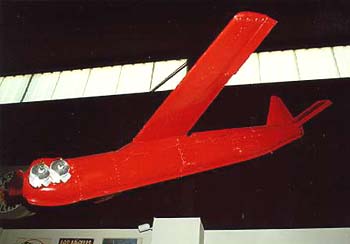 Radioplane OQ-19D (KD-2R3) Target Drone Photo : http://www.airmuseum.org/
The all metal constructed, radio controlled, target drone KD-2R3 (OQ-19D) was manually controlled at low altitudes, tracked with binoculars on a search light control up to 3,000ft and radar tracked at high altitude. Scale speed and size at 700ft simulates a 700mph jet fighter at a 300 yard range. [...] This particular drone was found intact by hunters in Okefenokee Swamp in southern Georgia. another article from the collection of Bob Harmon, this time from the Feb. 1952 edition of Air Trails
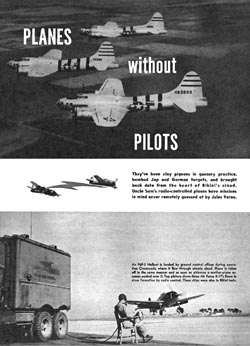 'Planes without Pilots', p.1 Air Trails, Feb., 1952 - Click Image to Enlarge
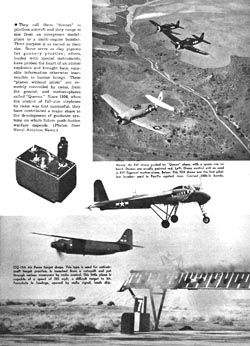 'Planes without Pilots', p.2 Air Trails, Feb., 1952 - Click Image to Enlarge
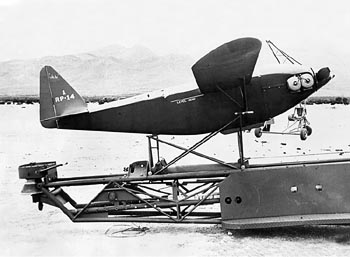 RP-14 'jake', (date t.b.a.) Photo : Righter Family Archives - Click Image to Enlarge Download a 1500 pixel image
Aerial Gunnery Target Aircraft From the 40th Bomb Wing, B-47 website (and specifically their Photo Gallery page 11), the following selected images and text relating to aerial gunnery training using radioplane drones as targets. The photographs were provided to the the host site [ http://www.geocities.com/Pentagon/Quarters/9396/gallery11.html - no longer on line Ed.] by S/Sgt. Glen Boren NCOIC of Aerial Gunnery at Smoky Hill AFB who can be contacted via the host site
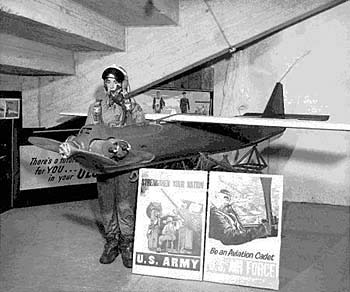 OQ-19D, Salina County Fair
The drone used at Smoky Hill AFB was the Radioplane OQ-19D which weighed 350 pounds, was of Aluminium construction (with a wingspan of eight feet) and was powered by a McCullough O-100-1, two cycle, air cooled, four cylinder engine enabling speeds of 200 Knots at sea level. This mighty little aircraft made it very interesting for the gunners of B-29's, B-47's and on into the B-52 and B-58 program and was next to impossible to hit by all but the best gunners that SAC had to offer. If a KILL was made, the gunner would be issued with a DeadEye Certificate honoring his accomplishment. At a later time the drones were equiped with radar reflectors for use with gun systems using radar lock-on's. I understand that later on with the use of radar, the gunnery range was forced to include a Radar deflection offset, the gunners were too good and costing the Air Force too much in downed drones. For those that did survive however, landing was accomplished by using a 24 foot cargo shute also deployed on command by radio control
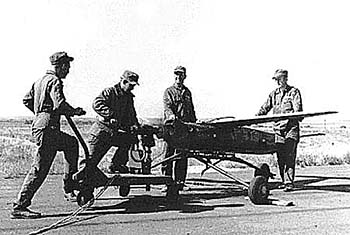
802nd Gunnery Range Crew preparing to launch a drone
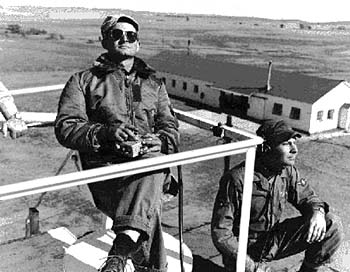 S/Sgt. Glen Boren flying an OQ-19D by radio control
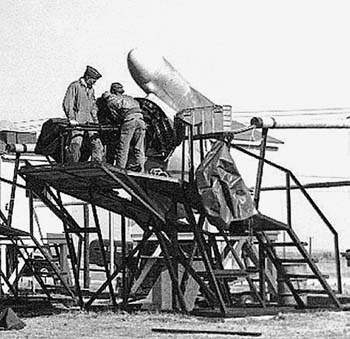 B-47 (twin 20mm cannon) Gunnery System
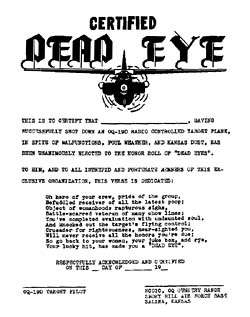 'DeadEye' Certificate
http://aeroweb.brooklyn.cuny.edu For decades Air Force bomber crews were required to undergo aerial gunnery training and practice. You've all probably seen those WWII-era movies showing B-17 gunners. Some were top turret gunners, others manned the side-mounted waist guns and there were also lower ball-turret and tail gunners. Even the bombardier in the aircraft nose had gunnery duties. For all it was a difficult job requiring both ground and aerial training. Less well-known by the general public was the gunnery training required of B-58 Defensive Systems Operators (DSO's). Unlike earlier bombers, the supersonic Mach 2 B-58 Hustler had just one gun position. That was the 20mm Vulcan gatling gun in the tail. It was operated by the DSO, who faced forward in his third seat, behind the pilot and navigator-bombardier. The DSO controlled the tail gun remotely, using a radar system with a special computer to adjust aiming at targets behind the airplane. The merits and effectiveness of this system are the subject of another article. DSO's were required to attend a formal gunnery training course at an Air Force base in Kansas. It was my luck to go there in the dead of winter with snow blowing like crazy and temperatures hovering near ten degrees. Yet it was an interesting and a very unique experience for this navigator turned electronic warfare officer and now tail gunner. The week-long gunnery course consisted of both classroom training and live firing at moving targets on the range. In my case this training program was mainly a "square-filling" requirement, for I was sent long after completing crew training and certification as combat ready. I had already fired the Vulcan system in the air over gunnery ranges off the Texas coast and over Lake Superior. The live-fire portion of our Kansas training first called for manually linking 4000 rounds of the heavy 20mm shells. We learned how to properly prepare the ammo belts and load them into the two metal boxes that were duplicates of the ones on the airplane. And then we were briefed on range safety and operations procedures for the live-fire exercise to follow. Our targets were real airplanes, radio-controlled models with wing spans of about ten feet and driven by wooden propellors. These target drones were launched from a circular rail system which enabled them to travel around until gaining flying speed. Then they sped off tangentially under the control of an operator seated in a tower behind the line of gun emplacements and turrets. Gun systems from B-47's, B-52's, B-58's and others were arranged in an arc facing the open range. The target drone "pilot" manipulated switches and a control stick to fly the targets in a pattern across the range that roughly corresponded to typical attack passes gunners might see in actual combat. On a signal from the controller we were told to acquire, track and shoot down the drone. A parachute recovery system on the drone would activate if the drone was hit, or if the unscathed drone was to be recovered for re-use. Target paths typically were a race-track course. Only on the inbound leg were we to shoot at 'em. The prize awarded to successful gunners was typically the wooden propellor of the drone. It was a sought-after trophy to be displayed by the proud sharp shooters. There was a "catch" though, one usually learned only upon completion of the course. Our gun systems were purposefully set off boresight so that making a hit was practically impossible. This was done to minimize the number of drones destroyed. Hits were thus typically accidental or lucky shots. For our radar-controlled B-58 gun systems, however, the process of inducing aiming errors by the school's staff was not as easy as adjusting optical or metal sights. And because of the high firing rate, 4000 rounds per minute, a lot of iron flew in front of the rapidly closing target. In some cases the drone merely flew into a hail of bullets, properly aimed or not. Yes, I actually hit my drone, But no, I did not "kill" it so did not qualify for a propellor trophy. I did have the satisfaction of damaging the target enough to preclude having the controller make his drone fly a victory roll on the last pass before deploying the recovery parachute. Close, but no cigar (propeller, in this case).
In 1952, Radioplane Co. became the Radioplane Division of Northrop Aircraft, Inc. Later the Radioplane Division became known as the Ventura Division, Northrop Corporation.
| ||||||||||||||||||||||||||||||||||||||||||||
© Copyright 1999-2005 CTIE - All Rights Reserved - Caution |